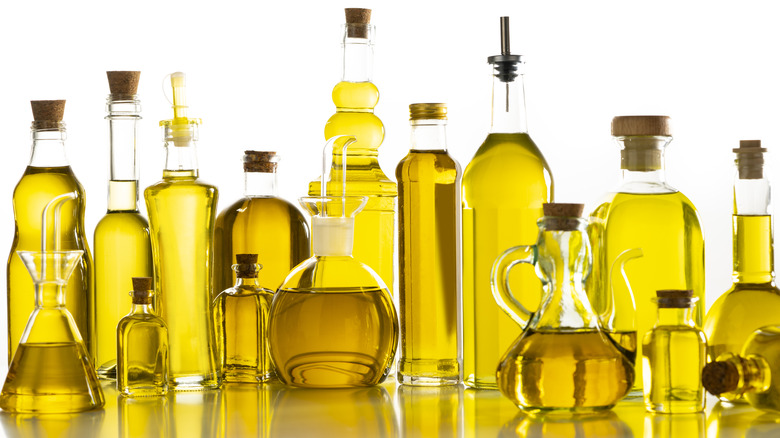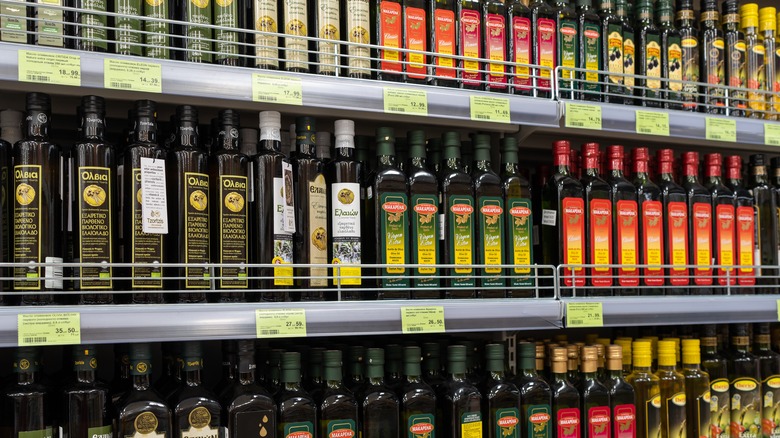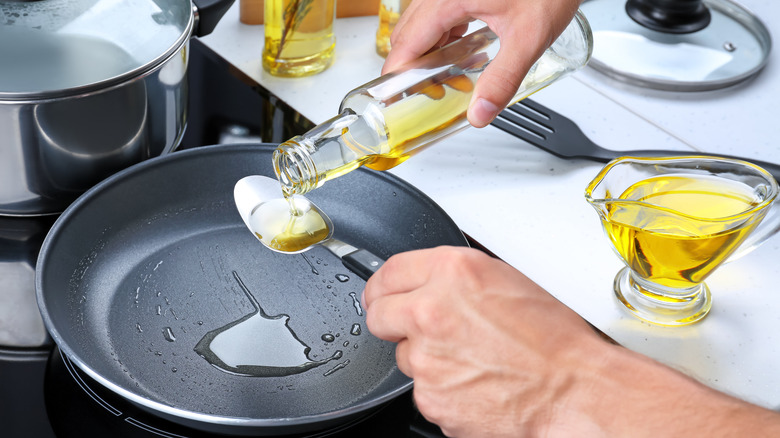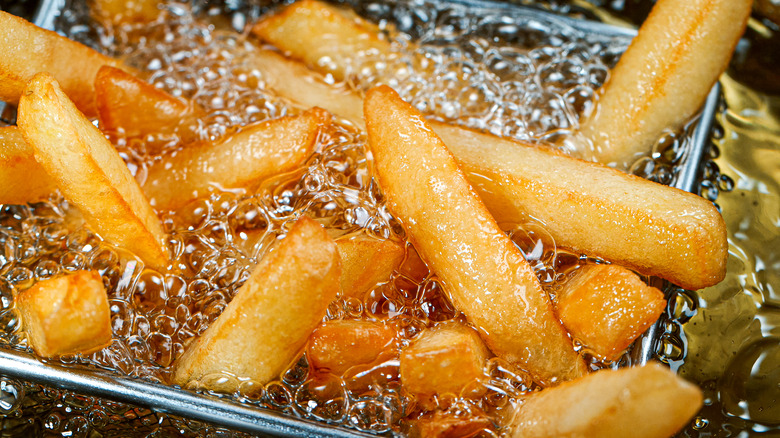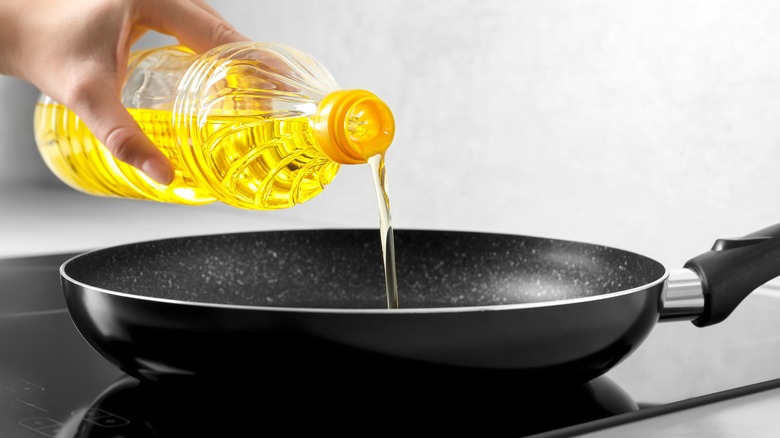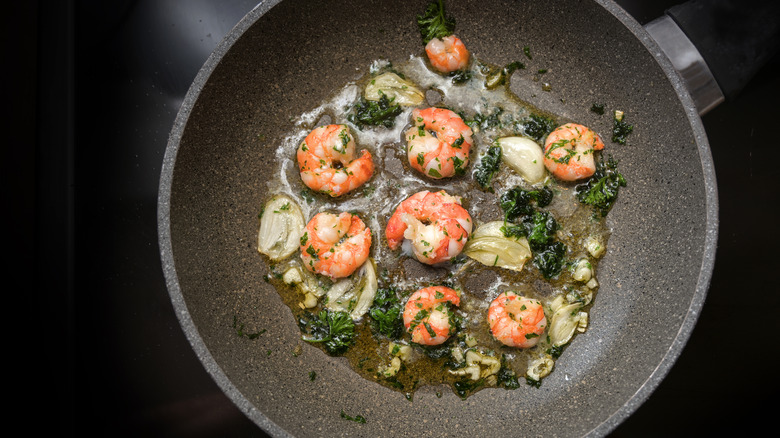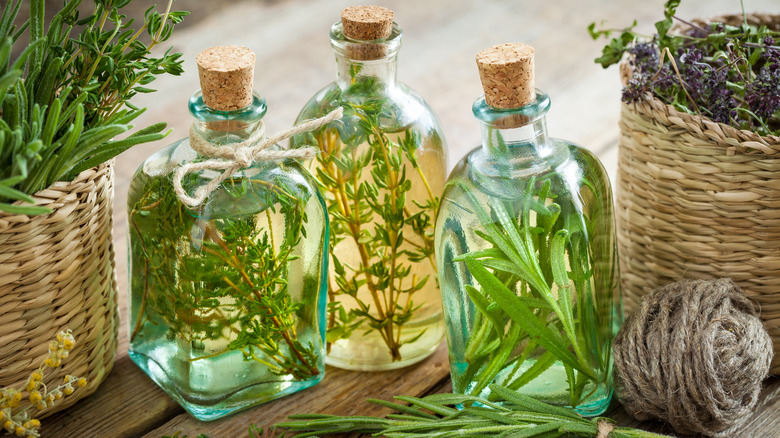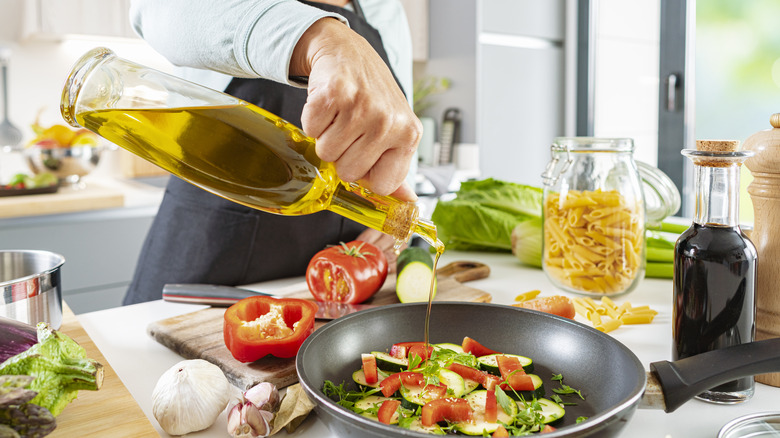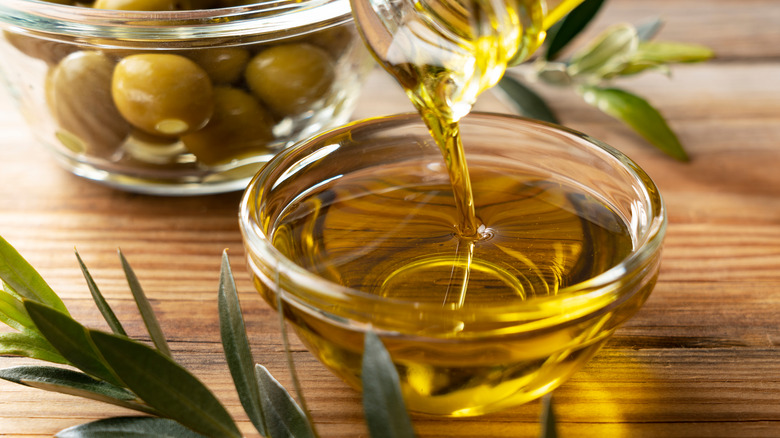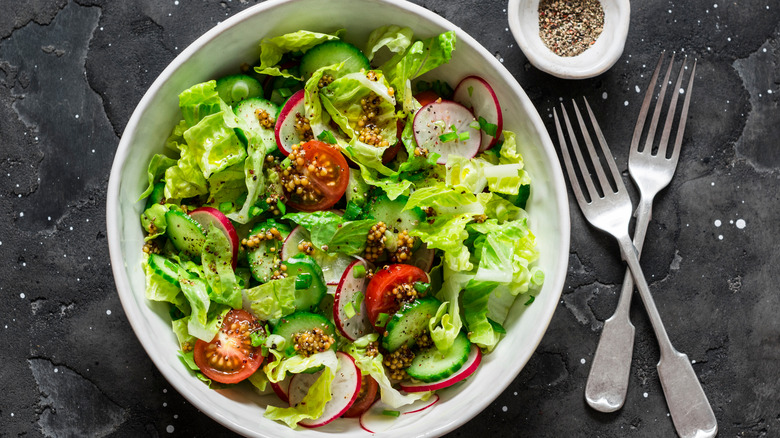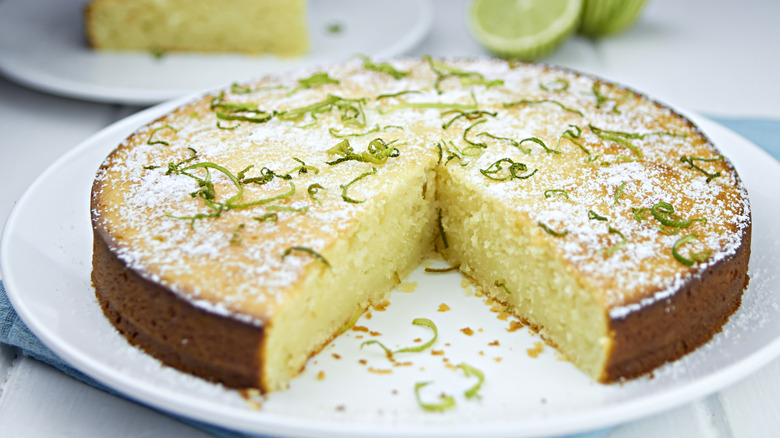Mistakes You Should Avoid When Cooking With Olive Oil
Olive oil is one of the most vital and useful ingredients any chef can have in their culinary arsenal. It's wonderful for sautéing and frying. You can use it to make flavorful and inventive salad dressings, and it's a perfect marinade for all types of proteins and produce. It helps to prevent foods you are grilling from sticking to the grill grates. It adds flavor and moisture to roast food, enhancing the caramelization process. Olive oil even makes an incredible dip or flavorful garnish — or use it as a topping for soups and stews that need a tiny kick of added flavor and pizzazz.
Yet despite all these varied and extraordinary uses, olive oil can also be a tricky ingredient to master. You need to know how to harness its goodness and put it to use the right way — which food and cooking techniques it works with and which it does not. Not knowing these basics, many of us make a number of common blunders in the kitchen whenever we try to cook with olive oil. We might expose it to the wrong temperatures, store it in less-than-ideal conditions, or pair it with the wrong foods — stuff that it really isn't meant to help shine. Keep reading to learn how to avoid these common olive oil mistakes, and start handling the olive oil in your kitchen like a true pro.
Thinking all types of olive oil are the same
The olive oil aisle in the supermarket can often seem overwhelming, so be careful: Don't just grab a bottle of that liquid gold and dart for the chips or produce. There's a lot going on within those bottles, so you need to think wisely when making your purchase. While it's true that all olive oil does come from olives — the fruits are crushed into a paste and then separated into liquids and solids — not all olive oils are the same. And we're not talking brands.
Extra virgin olive oil, or EVOO (as it's often affectionately known), is the least processed olive oil (via Medical News Today). It's never exposed to heat — the olives are pressed when cold. It's then minimally filtered to remove any leftover solids. It also has the boldest flavor, the most nutrients, and is best for preparations like salad dressings or as a dip for bread ... places where taste really matters.
Virgin olive oil is a bit harder to find but is processed similarly to EVOO. Manufacturers do allow "minor" flavor defects, although most of us would never know the difference. Regular olive oil is treated with heat to remove potential flavor defects and is the best general-purpose cooking oil. As for light oil, that name doesn't mean it's lower in calories. Instead, "light" oils are a mixture of refined and virgin oils. They're still suitable for cooking but tend to be blander and don't have much flavor on their own.
Letting your olive oil burn
Ever find yourself sautéing a steak or cooking up a piece of fish in a skillet and find the oil in your pan starting to smoke? If so, it likely wasn't your cooking technique that had your smoke detectors blaring like crazy. You may have just poured the wrong oil into your skillet.
You've likely heard in the past that it's better to cook certain foods on the stovetop with oil instead of butter. The problem with butter is that is what those in the culinary world call a "low smoke point." It can't get that hot before the melted butter starts to burn and let off smoke. Well, extra virgin olive oil, in particular, isn't that different than butter. It has a smoke point of around 350 degrees F, just 50 degrees above that of butter. That may be fine if you keep your stove set to medium or even medium-high temperatures. But if you let it get too hot, it's going to start to smoke — and that's going to impact the taste of your food.
That's why regular or light olive oils are much better options for cooking over higher temperatures. They have less wonderful olive flavor, to be sure, but their smoke point ranges from 350 to 410 degrees F. Meaning, you can cook with them at a much higher setting on your stove before things start to burn and smoke.
Assuming olive oil works well for all forms of cooking
If all types of cooking took place over medium-high heat, then olive oil could safely be the only oil you'd ever need in your kitchen. But that's just not the case. And that's why assuming you can cook anything you're craving with just a simple bottle of olive oil is another common mistake many of us make all the time.
While you're generally safe sautéing almost any type of protein or vegetable on the stove with your favorite brand of olive oil, things get trickier when you move on to other cooking preparations that involve even higher heat. Searing a steak to create a perfect caramelized crust can sometimes be a challenge with olive oil — it can start to smoke and burn if your stove is set at too high a temperature. Grilling and broiling are also problematic with olive oil since both involve heat levels that exceed olive oil's smoke point. And deep-frying anything with olive oil is generally considered a huge no-no. The oil just can't stand up to the high and prolonged levels of heat necessary for successful deep frying without starting to burn.
If you need to cook something over a really high temperature — 450 degrees F or more — stick with soils like sunflower, sesame, peanut, soybean, palm, avocado, or safflower. All have a much higher smoke point than olive oil and are better options for higher-temperature cooking.
Buying the cheap stuff
Given the choice between a great cut of steak and a lesser quality option, you might think you're making a good decision by going for the ribeye and then saving a few bucks with the cheaper, clear plastic bottle of olive oil. But make those cost-cutting decisions wisely. Olive oil is one of the areas in cooking where quality really does matter, and a couple of extra bucks spent on a bottle can make a world of difference in many meals you prepare. It can be the difference between a "meh" salad and one that sings with vibrant, garden freshness.
The most basic reason to buy higher quality olive oil is that it will taste better. You don't have to get the most expensive brand on the shelf, but you also shouldn't buy the absolute cheapest. You'd likely be very surprised by the flavor differences that exist between "budget" olive oils and their mid-level counterparts.
Pricier olive oils have more of that beautiful, grassy, briny olive flavor. They tend to be packaged better — in darker bottles that help to preserve flavor and freshness. They are also more likely to have expiration dates printed on their labels. Many cheaper olive oils don't and can end up sitting on shelves for an extended period before they get used, leading to even less of that wonderful "olive" flavor that makes these oils so delectable.
Not considering your oil's expiration date
Whether you're buying affordable or higher-priced olive oils, freshness matters. The more recently those olives were pressed into oil, the more likely you are to notice their unique and wondrous variety. Fresh, newly pressed olive oils can have hints of rich, spicy flavor or a lush, herbaceous quality. You might even notice the tingle of pepper or a whiff of citrus flavor.
But as olive oil sits in storage — even in your pantry or cupboard — those flavors can start to wane. Sunlight, in particular, is notorious for impacting the flavor of olive oil. That's why so many oils are packaged in green or dark-colored bottles. But even if your olive oil is stored in the dark, it won't last forever.
Unopened, a bottle of olive oil kept in ideal dark and cool storage is generally good for about 18 months. Once opened, you need to use that oil fairly soon — experts say it will typically hold up for about three to four months. If you cook often, using a bottle that quickly shouldn't be a problem. But if you have olive oil that's been lingering for a while, it may be a good idea to throw it away and start fresh.
To detect if your olive oil has expired, taste it — you'll know. You can also take a whiff. If it smells weird or rancid, that's a sign to buy a new bottle. Dark, cloudy oil or olive oil with a sour or bitter flavor has also likely spoiled.
Not reusing olive oil when cooking
Maybe you're sautéing large, succulent shrimp for a hearty salt and pepper shrimp stir-fry. Or perhaps you're making crisp, golden fried zucchini or fried green tomatoes, fresh from the garden. Whatever the case, you're likely cooking in batches and have one or more skillets of food to cook before you can assemble your meal. If this sounds familiar — and you're thinking you need to empty that skillet and add more oil before you start cooking round two — that's another common mistake you're making when cooking with olive oil.
In reality, you can reuse olive oil several times when cooking. Some say three times is acceptable; others insist the number is more like five. The truth is, the amount of times you can reuse your olive oil will vary. It depends on how high of a temperature you were cooking at and what you were cooking. If there was a lot of breading or you were cooking something that left debris in your oil, it can't be reused as easily as if the oil stayed clean while cooking.
To ensure maximum longevity in your oil and make sure you get through an entire meal (for example) without needing to replace it, opt for lower heat versus higher whenever possible. And keep your food as dry as you can before you put it in the oil. When water is released into oil as foods cook, that oil can start to break down, making reuse harder.
Not infusing the oil correctly
As marvelous as olive oil is on its own as an ingredient, it can be even better — and more delicious — once it's infused with something else, like garlic, basil, rosemary, lemon, chile peppers, or more. But there's a catch. For the best-tasting and most successful infused olive oils, you can't just throw a sprig of basil or a bundle of rosemary into a jar and top it off with oil. If you do, you likely won't get an oil with much flavor. Worse, you'll also be putting yourself at risk for some severe forms of food poisoning. That's because adding "fresh" or wet ingredients to oil creates a potential breeding ground for bacteria (via the North American Olive Oil Association). Infused oils made this way are also prone to mold growth.
Instead, to make an infused oil with fresh herbs from your garden, blend your herb leaves and oil in a blender until completely smooth. Next, pour the herb and oil mixture into a saucepan over medium heat and bring to a simmer. Let simmer for 45 seconds, then reduce heat and cool. Finally, strain the cooled oil through a coffee filter or fine cheesecloth, removing all solid debris. Pour the clarified oil into an airtight glass container and store it in the fridge. You'll need to use it within a few days. For longer-lasting infused oils, repeat the same process but use dried herbs instead. These oils should also be kept in the fridge but will last for several months.
Using more robust olive oils in delicate-flavored dishes
Pairing olive oils and the foods you are making or serving them with is essential — if you don't, the intense taste of the oil may overpower the subtle nuances of a dish. Or, on the flip side, a mild oil might seem virtually flavorless in contrast to the rich foods around it. For the best-tasting meals, your oil and food combos need to be in perfect unison.
Serving a robust extra virgin olive oil that's filled with bold, intense flavor plus notes of bitterness and pepper? If so, pair it with grilled meats, hearty soups like savory mushroom stew, or robustly flavored vegetables like broccoli, Brussels sprouts, cabbage, cauliflower, onions, or turnips. Rich olive oils also make an excellent oil to dip warm, crusty bread into and are a perfect complement to pasta packed with garlic or chiles. In addition to the variety of oil being used, olives grown in Italy's Tuscan region or Spain tend to have a strong, spicy kick and make the most flavorful recipe addition.
In contrast, some olives grown in France and California can be milder in flavor, as do more processed varieties of olive oil. Both are good options for drizzling over salads, fresh greens, or steamed vegetables. Lighter-tasting oils also work well with seafood and poultry, where they are less likely to overpower or make food seem heavy or oily.
Letting olive oil get too hot or too cold
Want to blow your mind? Consider this: Olives are a type of fruit, so olive oil is technically a fruit juice! Crazy thought, right? But it's also helpful to keep in mind when you think about how you store your olive oil in the kitchen. For starters, never store olive oil in a bottle directly next to your stove, where it's exposed to high temperatures regularly. This "on-again, off-again" heat makes your olive oil go bad faster. It speeds up the aging of the oil and can also cause it to be less flavorful over time.
On the other hand, you also don't want to let your olive oil get too cold. If you store it in an exceptionally cold fridge, for example, it might even solidify. And even in slightly warmer fridges, the olive oil may turn cloudy and start to look funny. Some chefs say this won't affect the quality or taste of the oil in the long run; others say it can permanently damage the oil over time, so it's definitely a source of fierce debate.
Instead, the best place to store your olive oil is somewhere cool, dark, and dry. A wine cellar is ideal, if you are lucky enough to have one. If not, you could also use a wine fridge — just let the oil warm to room temperature before using it. And if you don't, the back of a dark cupboard is perfectly fine, too.
Overdoing the olive oil in salads
Whether you're whipping up a light side salad made from a mix of baby spinach and leafy greens, or something a little heartier with kale, cheese, croutons, and diced chicken breast, salad dress is often the key to making the dish sing. It ties together all the flavors in the bowl, and brightens them, turning those disparate ingredients into one unified dish.
But the problem many people have when cooking with olive oil — and making salads in particular — is getting heavy-handed with the dressing. Too little dressing and your salad tastes dull and "naked." Too much, however, and it can turn into a greasy, soggy mess. Getting that "just right" balance is tricky, and requires a bit of finesse. But it's far from impossible.
For starters, if you are using a homemade salad dressing, make sure it's made with the proper ratio of ingredients: 3 parts olive oil to 1 part acid, like vinegar or citrus juice. This ensures better distribution and "cling" for the dressing, without adding excess moisture to your greens and making them watery. Then, as you apply the dressing, start with a small drizzle just before serving. Toss your salad until well mixed and taste. If it still seems dry, add more. Consider investing in a spray bottle for a more even distribution of the dressing. Or toss the salad with your hands so you can more accurately gauge the overall moisture content of the dish.
Not considering olive oil for desserts
Finally, when it comes to mistakes we sometimes make when cooking with olive oil, perhaps the biggest blunder is thinking olive oil dishes can only be savory. There's a world of incredible olive oil-based desserts out there, and all of them need a place on your menu, at least occasionally.
Olive oil cake, for example, is an imaginative and flavorful creation that's moist and decadent, especially when topped with citrus zest or toasted nuts. Olive oil cookies are soft and chewy with beautiful fruit notes often lacking in oil-free cookies. You can also whip up fudgy olive oil brownies, luscious olive oil ice cream, nutty olive oil biscotti, and even rich and indulgent olive oil chocolate mousse.
And even if it's not a main ingredient in their creation, there are also a number of desserts that benefit from a savory drizzle of olive oil. That's because olive oil acts a bit like salt when paired with these foods. It's a proven flavor enhancer, amplifying their naturally sweet tastes while also adding depth and complexity to their flavors. Think of it as adding cream to your coffee or smearing butter on your bread. You can drizzle a bit of rich, velvety olive oil on vanilla ice cream, tiramisu, baklava, Greek yogurt, panna cotta, lemon bars, fruit salad, and more. With its bold and dynamic flavor, it would be a mistake not to pour some on top of any already delectable dessert.

